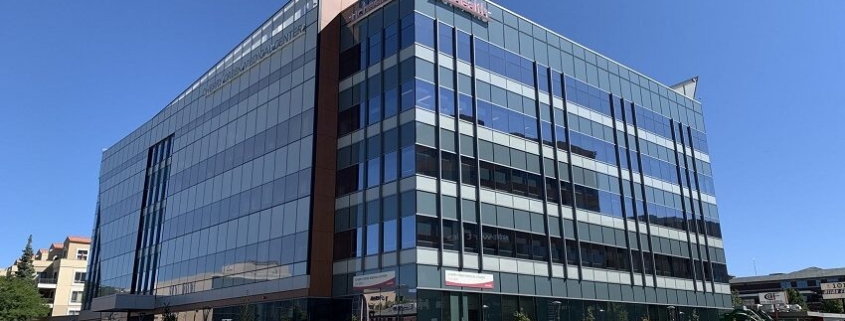The next time you visit your physician, your appointment may very well be virtual from the comfort of your own home.
Telehealth, or telemedicine, was an emerging part of healthcare delivery long before COVID-19. Now, the pandemic has catapulted the concept into national awareness. Changes in insurance reimbursement have expanded the availability of telehealth, with new implications for healthcare real estate occupiers, owners and investors.
What does “telehealth” mean, exactly? It encompasses electronic, interactive services ranging from a simple phone call or email with a clinician to a virtual exam with a caregiver for the purpose of diagnosis, intervention or ongoing care management. It’s enabled by such platforms as Doxy.me and NextGen Healthcare that make it easy to accept payments or insurance information in conjunction with an appointment.
Despite the convenience and effectiveness of telehealth, and the growth of secure telehealth platforms over the past decades, its pre-pandemic use was limited because of insurer reimbursement restrictions, Health Insurance Portability and Accountability Act (HIPAA) patient data privacy requirements, and practitioner concerns about malpractice.
However, when states began to enact stay-at-home orders in early March in response to the pandemic, telehealth gained new attention among policymakers as a solution to providing healthcare without further jeopardizing patient health. As a result, provisions in the Coronavirus Aid, Relief and Economic Security (CARES) Act lifted restrictions on where, how and with whom Medicare patients can access virtual care.
For the first time ever, there may be a critical mass of patients and practitioners alike able to tap the benefits of telehealth, mostly substituting onsite appointments with simple e-visits. Now, Medicare patients can access telehealth services from their own homes and healthcare providers can deliver service from any healthcare facility. Telehealth visits can take place via any phone with audio/video capabilities, using common consumer platforms such as FaceTime and Skype. Also important, first-time patient visits via telehealth are now eligible for Medicare coverage, too. Any healthcare professionals eligible to bill Medicare for their services can now bill Medicare for telehealth services, too.
From Stopgap Service To Structural Change
The acceleration of telehealth adoption may have been forced out of necessity during the pandemic. However, its use will likely continue to grow even after the pandemic fades.
In the post-pandemic era, the ease, efficiency and convenience of telehealth care will increase patient commitment and retention, and potentially lead to more in-person appointments for follow-up care. Telehealth also improves compliance with prescribed treatment plans, including follow-through on required appointments.
Also critical, telehealth enables patients in even the most remote and underserved locations to access care. And, it may prove to be especially well-suited for remote management of long-term chronic conditions such as allergies, diabetes and multiple sclerosis, and for monitoring such treatments as infusions and pacemakers.
As medical technology continues to advance at a rapid pace, an increasingly sophisticated suite of implantable and wearable devices, or even robotic telemedicine carts, will enhance home monitoring and management capabilities. Healthcare providers who implement this device-enabled “hospital at home” concept can help patients maintain their long-term health safely.
Telehealth’s Impact On Healthcare Real Estate
Clearly, telehealth usage has surged in 2020 to occupy a much more prominent place within the care spectrum than ever before. However, it’s important to keep the trend in perspective. According to FAIR Health’s private healthcare insurance claims data, only 0.17 percent of all services, or less than one-fifth of 1 percent, were provided via telehealth in the first quarter of 2019. In 2020, first quarter usage jumped to about 7.5 percent of services. April and May usage—data is not yet available—is forecasted to be higher than previous months. Thus, while telehealth usage has grown dramatically, its role in the healthcare service delivery spectrum continues to be secondary.
Yet, the long term may reveal a different story. As healthcare providers look to drive down costs while boosting reimbursements, telehealth’s role will likely become more prominent. As a result, many healthcare providers will need to reconfigure their facilities to provide HIPAA-compliant, technology-enabled spaces for the provision of telehealth and remote health monitoring services.
In light of the telehealth trend, the following are four steps healthcare occupiers, owners and investors should consider for the future of their facilities:
Develop telehealth care provider suites. Although patients will be able to participate in telehealth calls and remote health monitoring at home, practitioners will still need space for calls or electronic communications, as well as for remote monitoring and diagnostic equipment. Medical office buildings could provide suites for technicians and nurses to virtually manage intensive care, emergency and home care patients, for example. These spaces would require Internet redundancy, appropriate lighting, screens and acoustics, and assured patient-caregiver privacy for HIPAA regulatory compliance.
Reconfigure public spaces. Even as healthcare providers transition more basic care and monitoring services to online delivery, patients will still need office visits for advanced treatments, extensive physical evaluations and for use of advanced diagnostic equipment. However, the pandemic already has led healthcare providers to rethink their waiting room management to allow for social distancing. For instance, some providers ask patients to wait in their cars rather than in the waiting room and use text messaging to alert patients of their appointments.
With widespread adoption of digital patient registration and text messaging, less waiting room space will be needed even after the pandemic. An onsite kiosk, for example, could be used by patients to register upon entry, and possibly could support healthcare service delivery in other ways.
Reconfigure and repurpose healthcare delivery spaces. Many facilities will require interior reconfigurations, renovations and build-outs to support the transition to telehealth services. The adoption of telehealth care delivery will likely reduce the number of physical exam rooms needed in a healthcare facility and will free up square footage for other purposes. With less space required for physical exams, facilities can prioritize space for high-value imaging, diagnostics, injectables, wound care, advanced and acute treatments, obstetrics and laboratory services.
Pursuing The Possibilities Of Telehealth
As pandemic-related financial losses continue to mount across the healthcare sector, telehealth offers the potential to provide efficient, effective patient care while maximizing productivity-per-square-foot of healthcare real estate. For some healthcare providers, telehealth adoption could dramatically reduce the need for office space or increase the need for different kinds of spaces, depending on the services provided. Whatever the situation, healthcare providers, owners and investors have always been adept at adaptation—and many are already positioned to pursue the possibilities of telehealth.
Source: GlobeSt
 According to CBRE’s biannual report on the Denver medical office building market, which covers the first half of 2020, three projects totaling 124,000 square feet were delivered in the first half of the year, with 88.8 percent of the new supply pre leased. At the close of the second quarter, over 344,000 square feet of new MOB space was under construction. One was the 89,000-square-foot MOB at 100 Cook Street in Cherry Creek, which was 100 percent leased to UCHealth upon delivery.
According to CBRE’s biannual report on the Denver medical office building market, which covers the first half of 2020, three projects totaling 124,000 square feet were delivered in the first half of the year, with 88.8 percent of the new supply pre leased. At the close of the second quarter, over 344,000 square feet of new MOB space was under construction. One was the 89,000-square-foot MOB at 100 Cook Street in Cherry Creek, which was 100 percent leased to UCHealth upon delivery.



